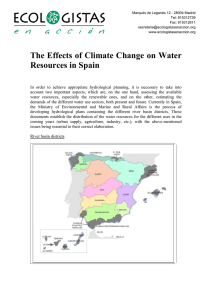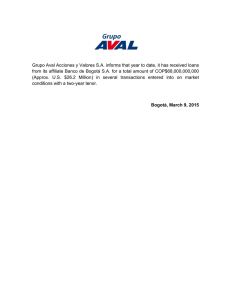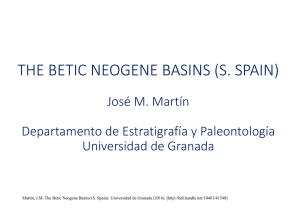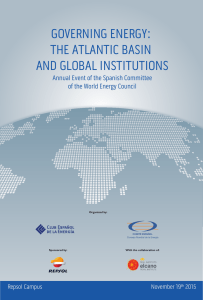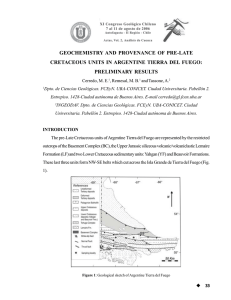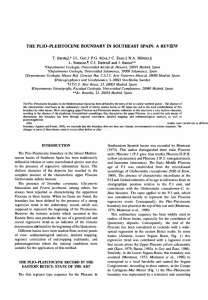Geological Framework of The Pacific Coast Sedimentary Basins
Anuncio
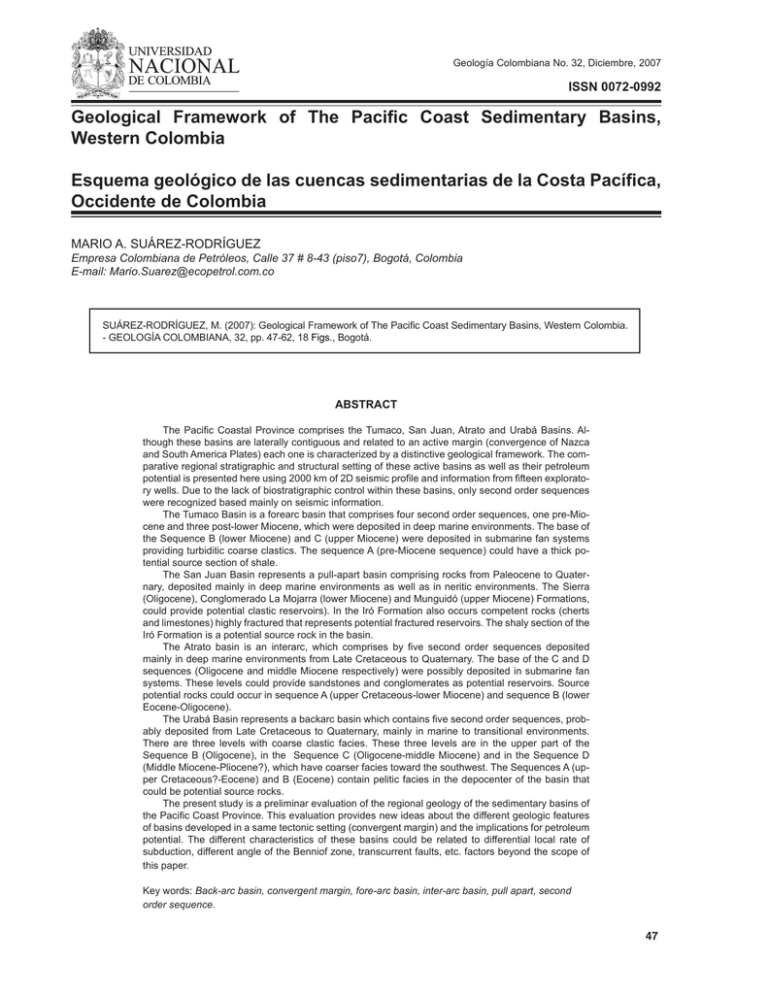
Geología Colombiana No. 32, Diciembre, 2007 ISSN 0072-0992 Geological Framework of The Pacific Coast Sedimentary Basins, Western Colombia Esquema geológico de las cuencas sedimentarias de la Costa Pacífica, Occidente de Colombia MARIO A. SUÁREZ-RODRÍGUEZ Empresa Colombiana de Petróleos, Calle 37 # 8-43 (piso7), Bogotá, Colombia E-mail: [email protected] SUÁREZ-RODRÍGUEZ, M. (2007): Geological Framework of The Pacific Coast Sedimentary Basins, Western Colombia. - GEOLOGÍA COLOMBIANA, 32, pp. 47-62, 18 Figs., Bogotá. ABSTRACT The Pacific Coastal Province comprises the Tumaco, San Juan, Atrato and Urabá Basins. Although these basins are laterally contiguous and related to an active margin (convergence of Nazca and South America Plates) each one is characterized by a distinctive geological framework. The comparative regional stratigraphic and structural setting of these active basins as well as their petroleum potential is presented here using 2000 km of 2D seismic profile and information from fifteen exploratory wells. Due to the lack of biostratigraphic control within these basins, only second order sequences were recognized based mainly on seismic information. The Tumaco Basin is a forearc basin that comprises four second order sequences, one pre-Miocene and three post-lower Miocene, which were deposited in deep marine environments. The base of the Sequence B (lower Miocene) and C (upper Miocene) were deposited in submarine fan systems providing turbiditic coarse clastics. The sequence A (pre-Miocene sequence) could have a thick potential source section of shale. The San Juan Basin represents a pull-apart basin comprising rocks from Paleocene to Quaternary, deposited mainly in deep marine environments as well as in neritic environments. The Sierra (Oligocene), Conglomerado La Mojarra (lower Miocene) and Munguidó (upper Miocene) Formations, could provide potential clastic reservoirs). In the Iró Formation also occurs competent rocks (cherts and limestones) highly fractured that represents potential fractured reservoirs. The shaly section of the Iró Formation is a potential source rock in the basin. The Atrato basin is an interarc, which comprises by five second order sequences deposited mainly in deep marine environments from Late Cretaceous to Quaternary. The base of the C and D sequences (Oligocene and middle Miocene respectively) were possibly deposited in submarine fan systems. These levels could provide sandstones and conglomerates as potential reservoirs. Source potential rocks could occur in sequence A (upper Cretaceous-lower Miocene) and sequence B (lower Eocene-Oligocene). The Urabá Basin represents a backarc basin which contains five second order sequences, probably deposited from Late Cretaceous to Quaternary, mainly in marine to transitional environments. There are three levels with coarse clastic facies. These three levels are in the upper part of the Sequence B (Oligocene), in the Sequence C (Oligocene-middle Miocene) and in the Sequence D (Middle Miocene-Pliocene?), which have coarser facies toward the southwest. The Sequences A (upper Cretaceous?-Eocene) and B (Eocene) contain pelitic facies in the depocenter of the basin that could be potential source rocks. The present study is a preliminar evaluation of the regional geology of the sedimentary basins of the Pacific Coast Province. This evaluation provides new ideas about the different geologic features of basins developed in a same tectonic setting (convergent margin) and the implications for petroleum potential. The different characteristics of these basins could be related to differential local rate of subduction, different angle of the Benniof zone, transcurrent faults, etc. factors beyond the scope of this paper. Key words: Back-arc basin, convergent margin, fore-arc basin, inter-arc basin, pull apart, second order sequence. 47 Suárez-Rodríguez: Geological Framework of The Pacific Coast Sedimentary Basins RESUMEN La Provincia sedimentaria de la costa Pacífica comprende 4 cuencas sedimentarias: Tumaco, San Juan, Atrato y Urabá. Aunque estas cuencas son lateralmente contiguas y relacionadas a un margen activo (convergencia de Placas Nazca y Suramérica) cada una tiene un esquema geológico distintivo. La estratigrafía, estructura y posibilidades hidrocarburíferas son presentadas de manera comparativa, con base en interpretación regional de 2000 km de perfiles sísmicos e información de 15 pozos exploratorios. Debido a la carencia de control bioestratigráfico robusto, solamente secuencias de segundo orden fueron reconocidas con base en información de reflexión sísmica. La Cuenca de Tumaco es de antearco y contiene 4 secuencias de segundo orden, una pre-Mioceno y tres post-Mioceno inferior, depositadas en ambientes marinos profundos. La base de la Secuencia B (Mioceno inferior) y C (Mioceno superior) fueron depositados en sistemas de abanicos submarinos con presencia de clásticos gruesos. La Secuencia A (secuencia pre-Mioceno) podría contener una gruesa sección de shale con potencial roca generadora. La Cuenca de San Juan representa una cuenca de desgarre y comprende rocas sedimentarias del Paleoceno al Cuaternario, depositadas principalmente en ambientes marinos profundos y neríticos. Las formaciones Sierra (Oligoceno), Conglomerado La Mojarra (Mioceno inferior) y Munguidó (Mioceno superior) podrían contener potenciales almacenadores clásticos. En la Formación Iró ocurren rocas competentes (cherts y calizas) altamente fracturados que representan potenciales almacenadores fracturados. La sección de shale de la Formación Iró podría ser potencial roca almacenadora en esta cuenca. La Cuenca de Atrato es de interarcos y comprende 5 secuencias de segundo orden depositadas principalmente en ambientes marinos profundos desde el Cretáceo a Cuaternario. La base de las secuencias C y D (Oligoceno y Mioceno medio respectivamente) fueron posiblemente depositadas en sistemas de abanicos submarinos. Estos niveles podrían contener arenitas y conglomerados como potenciales almacenadores. Rocas generadoras potenciales podrían ocurrir en la Secuencia A (Cretáceo superior-Mioceno inferior) y en la Secuencia B (Eoceno inferior-Oligoceno). La Cuenca de Urabá es de trasarco y contiene 5 secuencias de segundo orden, probablemente depositadas desde el Cretáceo tardío al Cuaternario, principalmente en ambientes marinos a transicionales. Hay tres niveles con facies clásticas gruesas. Estos tres niveles están en la parte superior de la Secuencia B (Oligoceno), en la Secuencia C (Oligoceno-Mioceno medio) y en la Secuencia D (Mioceno medioPlioceno?), las cuales contienen facies gruesas hacia el suroccidente. La Secuencia A (Cretáceo superior?Eoceno) y B (Eoceno) contienen facies pelíticas en el depocentro que podrían representar potenciales rocas generadoras. El presente estudio es una evaluación preliminar de la geología regional de las cuencas de la Provincia sedimentaria de la Costa Pacífica. Esta evaluación provee nuevas ideas acerca de los diferentes rasgos geológicos de cuencas desarrolladas en un ambiente tectónico convergente y las implicaciones para su potencial hidrocarburífero. Las diferentes características de estas cuencas podría estar relacionadas a diferencias locales en la taza de subducción, cambios en el ángulo de la zona de Benioff, fallas transcurrentes, etc. factores fuera del alcance de este trabajo. Palabras Clave: Cuenca antearco, cuenca desgarre, cuenca interarco, cuenca trasarco, margen convergente, secuencia de segundo orden. INTRODUCTION In Colombia, the regional evaluation and hydrocarbon exploration have been concentrated mainly in six of the eighteen existing sedimentary basins. Nevertheless, and as a result of current global requirements to increase the geological knowledge of frontier basins, the exploration activities have been shifting towards more unknown zones, with higher risk, but also with considerable possibilities of large hydrocarbon discoveries. Along these lines, the Pacific Coast Province (Fig. 1) appears to be an interesting and promising region for hydrocarbon exploration, since this province comprises four different sedimentary basins not yet well known geologically. Besides, former studies have treated the Pacific Coast as part of the called Bolivar Geosynclinal (SCHURTERT 1934 in DUQUE 1971, NYGREN 1950 in DUQUE 1971), which was supposed to comprise two major Tertiary sedimentary cycles from the Caribbean sea of Colombia to the norhtwest coast of 48 Perú. Afterward, BANDY (1968) recognized three Tertiary sedimentation cycles in the Chocó area. Later, DUQUE (1990a) proposed the Atrato basin as a different sedimentary element within the Pacific Coast. The purpose of this work is to propose four different sedimentary elements within the Pacific Coast: the Tumaco, San Juan, Atrato and Urabá basins. Each one of these basins has its own tectonic setting, sedimentary history and hydrocarbon potential. These elements define the Pacific Coast Sedimentary Province as an attractive area for research in convergent margins as well for exploration of new hydrocarbon reserves. The most important characteristics of the four basins are described here, focused on the tectonic setting, stratigraphy and hydrocarbon potential. LOCATION The Pacific Coast Sedimentary Province is located in the western sector of Colombia comprising the lowlands of Fig. 1. Location map of the Pacific Coast Sedimentary Province. This province comprises de lowlands west of the the Western Cordillera and extends offshore to the present acrretional arc of the convergent margin between the Nazca and South America plates. Fig. 2. Seismic sections and exploratory wells interpreted in this work. Seismic surveys were acquired from 1971 to 1991. Geología Colombiana No. 32, Diciembre, 2007 49 Fig. 3.Sedimentary basins of the Pacific Coast Province. The province comprises four sedimentary basins: Tumaco, San Juan, Atrato and Urabá. Fig. 4. Major tectonic and structural elements of the Pacific Coast Province. The information was compiled from GALVIS (1980), GARCIA & PRINCE (1982), ALVAREZ (1983), ETAYO et al. (1983) and DUQUE (1989). Suárez-Rodríguez: Geological Framework of The Pacific Coast Sedimentary Basins 50 Geología Colombiana No. 32, Diciembre, 2007 the Pacific and most of the shelf of the Pacific Ocean (Fig. 1). The eastern boundary is the Western Cordillera of the Colombian Andes, and the western boundary is the bathymetric curve of 200 m and the Serranía de Baudó (Fig. 1). DATA BASE Several 2D exploration seismic programs have been carried out in the area from 1971 to 1992, both onshore and offshore reaching more than 15000 km and 15 exploratory wells have been drilled. This study is based on 2000 km of regional offshore and onshore 2D seismic profiles and on the analyses and interpretation of geological information from the fifteen exploratory wells drilled in the province (Fig. 2). Also, regional gravity and magnetic surveys as well as geochemical and biostratographic analysis from cores and plugs are included. PACIFIC COAST SEDIMENTARY PROVINCE With this name is recognized the former named ChocóPacifico basin (CÁCERES 1990), to indicate the presence of more than one sedimentary basin in this region of Colombia. The term “Sedimentary Province” is used in sensu St. JOHN et al. (1987) to define an area with sedimentary accumulations greater than 1000 meters of thickness, which includes basins, and folded belts. The Pacific Coast Sedimentary Province comprises the Tumaco, the San Juan, the Atrato and the Urabá basins (Fig. 3). Regional Geological Setting The Pacific Coast is framed within the global plate tectonics environment that has formed the Colombian western area after the collision of oceanic material from the Pacific paleoplate against South America, while separation of South America and Africa was taking place during the Mesozoic. Plate convergence continues today with the Nazca plate subsiding beneath the western margin of South America. In Colombia this convergence has resulted in accretion of oceanic rocks, represented mainly by the Western Cordillera. The Atrato Fault System is the eastern boundary of the Pacific Coast Sedimentary Province to the south (Figs. 3, 4). The Western Cordillera is composed of three allochthonous terranes (ETAYO et al. 1983), the Cauca-Dagua terrane in the south, which represents an immature island arc (BARRERO 1979). The central part comprises the Cañas Gordas terrane, composed of oceanic crust (Figs. 3, 4). The accretion of these two terranes took place during Late Cretaceous to Early Tertiary times (ETAYO et al. 1983). The northernmost part of the Western Cordillera corresponds to the Buriticá Terrane (oceanic crust) accreted during the early Cretaceous (ETAYO et al. 1983). DUQUE (1989), defined another tectonic element in the northwest part of the western Cordillera named the Dabeiba Arc. The Dabeiba Arc was formerly included by ETAYO et al. (1983) in the Cañas Gordas Terrane. However the Dabeiba Arc is part of the named Chocó Block (DUQUE 1990b). This block is considered an allochthonous terrane with no lithogenetic affinity with South America. Based on microfaunal studies, its origin from latitudes as far as Guatemala and Mexico is proposed. The Chocó Block is composed of three structural and lithogenetic elements: The Dabeiba and Baudó Arcs, the Atrato basin and the deformed Istmina zone (Figs. 3. 4). The Dabeiba and Baudó Arc show similar magnetic interpretation (GEOTERREX 1979) (Fig. 5) and similar gravity anomalies (CASE et al. 1973 in OCOLA et al. 1975, BRICEÑO 1978) (Fig. 6) related to igneous bodies of oceanic origin. The Uramita Fault System is the structural boundary between the Chocó Block and the Western Cordillera. The San Juan Fault System represents the southern boundary of the Chocó Block (Fig. 4). Based on the previous tectonic framework, four sedimentary basins can be recognized within the Pacific Coast Sedimentary Province (Fig. 3). To the south, the Tumaco that represents a forearc basin related to the subduction process that originated the accretion of the Cauca-Dagua Terrane (Fig. 4). Within the Istmina Zone the San Juan basin represents a transpresional pull-apart basin related to wrench tectonics of the Garrapatas and San Juan fault systems (Figs. 3-5). To the north, the Atrato basin is associated to the evolution of the Chocó Block and represents an interarc basin (Figs. 3, 4). In the northernmost part the Urabá basin (Fig. 3, 4) represents a backarc basin related to the extension of the Dabeiba Arc. Stratigraphy The second order sequences defined for the four basins are different, both in number and lithology indicating different tectonostratigraphic controls on the formation and evolution of individual basins. In the Pacific Coast Province the Cretaceous oceanic rocks form the basement, on which Eocene to Pliocene sediments were deposited. However, the presence of upper Cretaceous to Paleocene deposits towards the basin depocenter is possible, considering the great thickness of pre-Eocene intervals that can be observed in some seismic sections. In the Tumaco basin the basement is composed by the upper Cretaceous Grupo Diabásico (NELSON 1962, BARRERO 1979) (Fig. 7). This group is formed by mafic vulcanites (diabases, basalts, pillow lavas), polymictic intercalations, chert, greywackes and calcareous siltstones (NELSON 1962, BARRERO 1979). Overlaying the basement, four second order sequences (sensu MITCHUM & VAN WAGONER 1991) were recognized (Fig. 7). The Sequence A (pre-middle Miocene), is composed by four lithostratographic units. At the base, “Unit 1S” is composed by mudstones, sandstones and limestones. This unit presents a facies change toward the north to conglomerates of the “Unit 1N”. Overlaying these units occurs the Lower Cayapas Formation (SCHWEINFURTH in WAINOCO INT. INC. 1980) that consists of shales, claystones and siltstones with thin limestones and sandstone layers. The Upper Cayapas Formation (SCH- 51 Fig. 5. Regional magnetic map of the Pacific Coast Province converted to depth. In the northern part is presented the final interpretation of blocks with different magnetic behavior. Main depocenters are indicated by this potential field. Notice the contrasting east-west trend in the central part (which represents the San Juan Basin) compared with the regional south-north trend of the main depocenters. The information was compiled from AERO SERVICE (1977), FRIEDBERG (1977 in OJEDA & CALIFE 1987) and GEOTERREX (1979). Fig. 6. Regional gravity map of the Pacific Coast Province. Main basement trends are parallel to the main depocenters observed in figure 5, indicating a regional similar response of the two potential fields. The information was compiled from HAYES (1966 in OCOLA et al. 1975), CASE et al. (1971 in OCOLA et al. 1975) and CASE et al. (1971 in OCOLA et al. 1975). Suárez-Rodríguez: Geological Framework of The Pacific Coast Sedimentary Basins 52 Geología Colombiana No. 32, Diciembre, 2007 Fig. 7. Stratigraphy of the Tumaco Basin. Second order sequences represent chronostratigraphic units comprising one or two lithostratigraphic units due to facial change. Potential source and reservoirs intervals are indicated. Inferred Paleocene and Eocene intervals are observed in seismic sections. The column represents the total thickness in the depocenter of the basin. Fig. 8. Stratigraphy of the San Juan Basin. Due to the structural complexity of the basin second order sequences were not recognized, the lithostratigraphy is presented here. Potential source intervals (including TOC and SCI values) and reservoirs intervals as well as depositional environments are indicated. The column represents the maximum thickness of section observed in the field as described by FIGUEROA & NUÑEZ (1990). WEINFURTH in WAINOCO INT. INC. 1980) caps this sequence, it is composed of claystones, sandstones and limestones. These units would form mud diapires present in the basin. Sequence B (middle Miocene-early upper Miocene) comprises at its base the Viche Formation to the south part of the basin and the Lower Naya Formation to the north (Fig. 7). These two formations are coeval. The Viche Formation is composed of siltstones and mudstones (WAINOCO INT. INC. 1980). The Lower Naya Formation consists of conglomerates and sandstones with interbedded tobaceous levels. The Angostura Formation occurs above the mentioned units in the south part of the basin and the Upper Naya Formation in the northern part, which are coeval. The Angostura Formation consists of sandstones, conglomerates and tobaceous levels. The Upper Naya Formation consists essentially of shales, claystones and sandstones with thin intervals of conglomeratic sandstones. Sequence C (upper Miocene) comprises, in the lower part, the Chagüí Formation and in the upper part the San Agustin Formation (Fig. 7). The Chagüí Formation is formed by alternating thick beds of claystones, shales, siltstones and calcareous mudstones interlayered with thick beds of sandstone and conglomeratic sandstones with volcanic tuff and mafic rocks fragments. The San Agustin 53 Suárez-Rodríguez: Geological Framework of The Pacific Coast Sedimentary Basins Formation consists of thick beds of claystones, siltstones and argillaceous siltstones iterbedded with thick beds or tuffaceous sandstones. Sequence D (Pliocene) corresponds to the Guapi Formation and consists of conglomerates with thin limestone layers. In the San Juan basin no sequences were interpreted due to the high structural complexity of the basin and the lack of biostratigraphic information. For this reason only the lithostratighraphic units are presented (Fig. 8). The basement is composed of slates, quartzites, and metasandstones of the Lower Cretaceous Dagua Group (NELSON 1957) and by mafic vulcanites such as basalts and diabases of the Upper Cretaceous Grupo Diabásico (NELSON 1962). Overlying this basement lies the Iró Formation (Palaeocene-Eocene) formed by chert, siliceous shales, finely laminated black shales rich in organic matter, claystones, medium-grained grey lithic sandstones and grey limestones (Figueroa and Nuñez, 1990). Faneritic igneous rocks of variable composition are frequently interbedded. Above the Iró Formation lies unconformably the Sierra Formation (Oligocene) consisting of basal conglomerates, limestones, calcarenites, siltstones and sandstones (FIGUEROA & NUÑEZ 1990) (Fig. 8). Overlying the Sierra Formation uncomformably occurs the San Juan Group (lower Miocene) formed by the Istmina, the Conglomerado La Mojarra and the Condoto formations (FIGUEROA & NUÑEZ, 1990) (Fig. 8). The Istmina Formation includes fine clastic beds interlayered with conglomeratic lenses (FIGUEROA & NUÑEZ 1990). The Conglomerado la Mojarra Formation is composed of conglomerates and conglomeratic sandstones with some siltstone and sandy claystone interbeds (FIGUEROA & NUÑEZ 1990). The Condoto Formation is mainly formed by sandstones, conglomerates, and shales (FIGUEROA & NUÑEZ 1990). Overlying unconformably the Condoto Formation is the Munguidó Formation (upper Miocene) (FIGUEROA & NUÑEZ 1990). It is composed of grey and brown fine-grained to conglomeratic sandstones, rich in carbonaceous material (FIGUEROA & NUÑEZ 1990). Overlaying the Munguidó Formation occurs the Atrato Formation (Pliocene-Quaternary), which is mainly formed by conglomerates and muddy siltstones (FIGUEROA & NUÑEZ 1990). In the Atrato basin the Lower Cretaceous basement outcrops in the Dabeiba and the Baudó Arcs (Fig. 4). The Dabeiba arc is composed of diabases, basalts, tuffs and agglomerates of the Barroso Formation (Alvarez and González, 1978). The Baudó Arc comprises basalts, agglomerates, tuffs and sedimentites (CASE et al. 1971 in ALVAREZ 1983); sequences that by their similarity with those in the Dabeiba Arc may correspond with the Barroso Formation. Overlaying the basement there are five second order sequences (sensu MITCHUM & VAN WAGONER 1991) (Fig. 9). Sequence A (Paleocene?-lower Eocene) comprising the Vallesi and Clavo formations. The Vallesi Formation lies unconformably on the Cretaceous basement and is composed of siliceous limestones (cherty limestone) in thin layers, very tight and fractured, with thin interbeds of gray shales (HAF- 54 1967). The Clavo Formation is formed by very tight dark gray shales, siltstones and interbedded calcareous shales and limestones, becoming sandier towards the depocenter and the eastern part of the basin. Sequence B (lower Eocene-lower Oligocene) corresponds to the Salaqui Formation (Fig. 9). The lower part of this formation is unknown and there is only seismic evidence of this interval. The upper part consists of well stratified limestones with lenticular chert layers, some tuffaceous marls and sandstones at the base (HAFFER 1967). The eastern sector has terrigenous facies. Sequence C (Oligocene-upper middle Miocene) is formed by the Uva and Napipi formations (Fig. 9). In the depocenter and the western part of the basin the Uva Formation is composed of marls interlayered with claystones, mudstones, calcarenites and some limestones. To the east there is a facies change to sandy and conglomeratic facies. The Napipi Formation consists of massive nodular siltstones and mudstones with occasional lenticular limestone beds (HAFFER 1967). Toward the west, this facies is more calcareous. Sequence D (Middle Miocene-Pliocene?) comprises the Sierra (HAFFER 1967) and Munguidó (DUQUE 1990 a) formations (Fig. 9). The Sierra Formation is composed of massive and calcareous muddy siltstones, with interbedded sandstones and sandy limestones towards the depocenter and to the west of the basin. In the eastern side, this formation is composed of sandy-conglomerates with silty levels. The Munguido Formation is formed by mudstones, shales and sandstones, with occasional marls levels and limestones to the top. Sequence E (Pliocene-Quaternary?) corresponds to the Quibdó Formation and the Quaternary units. The Quibdó Formation is formed by multi-colored silty sandstones, alternating with medium-grained clayly sandstones and occasional conglomerates with quartz pebbles (HAFFER 1967). Quaternary deposits are formed mainly by gravels, sands and sandstones, corresponding to alluvial deposits of the Atrato River. FER In the Urabá basin the basement is composed by the Upper Cretaceous Barroso Formation that consists mainly of volcanic rocks as basalts and diabases (HALL et al. 1972, ALVAREZ & GONZÁLEZ 1978). Overlying the basement rest five second order sequences (sensu MITCHUM & VAN WAGONER 1991) (Fig. 10). Sequence A (Paleocene?-lower Eocene?) was identified based on seismic information. HAFFER (1967) predicted the presence of this interval in the depocenter of the Urabá basin and informally called this interval the “Chengüe Formation” taking the name for the same time interval defined the Sinú and San Jorge River areas (Lower Magdalena Valley Sedimentary Province). Sequence B (Eocene-Oligocene) comprises the San Jacinto and the Maralú formations (Fig. 10). The San Jacinto Formation is identified only on seismic information, but HAFFER (1967) also inferred the presence of this interval in the basin and named it informally “San Jacinto Formation” taking the name from the same time interval found in the Sinú River region. The Maralú Formation is composed of massive sandstones and conglomerates in the western part of the basin (HAFFER 1967); towards the basin depocenter the facies become dominantly muddy. Sequence C (Oligocene–middle Mio- Geología Colombiana No. 32, Diciembre, 2007 Fig. 9. Stratigraphy of the Atrato Basin. Second order sequences represent chronostratigraphic units comprising one lithostratigraphic units or internal facial change. Potential source and reservoirs intervals are indicated. Inferred Eocene interval is observed in seismic sections. The column represents the total thickness in the depocenter of the basin. Fig. 10. Stratigraphy of the Urabá Basin. Second order sequences represent chronostratigraphic units comprising one lithostratigraphic units or internal facial changes. Potential source and reservoirs intervals are indicated. Inferred Paleocene and Eocene intervals are observed in seismic sections. The column represents the total thickness in the depocenter of the basin. cene) corresponds to the Floresanto Formation that consists mainly of claystones and siltstones locally calcareous; there are interbedded thin sandstone and conglomerate layers (HAFFER 1967). To the north, there are marls in the lower part of this formation. Sequence D (middle Miocene– Pliocene) is composed by the Pajuil Formation composed of alternation of thick sandstone and conglomeratic sandstone packages with very thick claystones and siltstone beds (HAFFER 1967). Claystones beds increase upward in the section. Towards the north, facies turn more argillaceous. Sequence E (Pliocene–Quaternary) comprises the Corpa Formation that consists of sandstones, conglomerates and claystones, with conglomeratic facies towards the south. The Quaternary is represented by alluvial deposits related to the Atrato River and are mainly claystones and conglomerates. Structure The basins of the Pacific Coast Sedimentary Province have different tectonic setting within the convergent margin as well as different structural style. The Tumaco basin corresponds to a forearc basin, in an active margin, formed from Tertiary subduction. The subduction produced a depression parallel to the paleoline coast between the external accretional arch and the Western Cordillera, where the fill of the basin took place (Fig. 55 Suárez-Rodríguez: Geological Framework of The Pacific Coast Sedimentary Basins 11). The existence of a basement paleohigh can be seen, separating two depocenters in the basin, being the eastern depocenter deeper (continental area). This paleohigh separates two sectors with different structural characteristics (Fig. 11). Towards the continent, there is no major tectonic deformation, and only a slight folding generated mainly by incipient mud diapirism and minor faulting is observed. Towards the ocean sector, there is a stronger structural deformation with mud diapirism (Fig. 12). Narrow folds and high-angle normal faults dipping to the west are present. The San Juan basin is defined between the San Juan and Garrapatas fault systems (Fig. 4, 13), in the named Istmina deformed zone (DUQUE 1989). In this zone, the structures have a N45°E to N60°E trend. Compressive tectonics are evident with a strike component (Fig. 14). The deformed strip is relatively narrow, with numerous facial changes (FIGUEROA & NUÑEZ 1990); evidence of sindepositional tectonics makes correlation of reflectors difficult. Due to the position of the two main wrench fault systems and the complexity this province could correspond to a pull-apart basin (Fig. 4, 13). The Atrato basin corresponds to an interarc basin zone developed between the Dabeiba and the Atrato Arches (Fig. 15). The structures here have a N-S trend, with general symmetric and gentle folds. The subsurface shows intense reverse low to medium angle faulting affecting Cretaceous rocks, and in a minor degree affecting the lower Tertiary section (Fig. 16). Toward the South, close to the San Juan Fault system faulting increase affecting the Tertiary section. The Urabá• basin represents a backarc basin developed behind the Dabeiba Arc (Fig. 17). It has a N35°W to N45°W regional trend (RESTREPO & PÉREZ 1982). In general, the Cretaceous sequence is affected by inverse faulting which occurred at the end of the Cretaceous during a strong compressive regime (Fig. 18). In contrast, the Tertiary section shows little evidence of deformation (Fig. 18). Hydrocarbon Potential The Pacific Coast Province provides varied opportunities for hydrocarbon exploration and eventual discoveries, considering the structural and stratigraphic potential for hydrocarbon trapping and the presence of potential reservoirs. This section describes the main regional leads based on the structural style, stratigraphic potential and reservoir potential prediction. Within the Tumaco basin the most interesting area lies on the eastern margin, considering possible quartz supply from intermediate to acid intrusions located in the Western Cordillera (Fig. 11), which would substantially improve the reservoir quality. The base of Sequences B (lower Miocene) and C (upper Miocene) were deposited in basin fans and slope fans providing turbiditic coarse clastics (Fig. 7). These clastics could represent potential reservoirs for hydrocarbon accumulations. The same area, being close to the block’s 56 deepest depocenter and being the one with the lowest pressure, is susceptible of having migration from the deepest zones. Stratigraphic entrapment is especially attractive in this sector due to the presence of turbiditic reservoir units, which onlap toward the East. Interest in this sector lies also on the possible presence of structural traps related to diapirism and faulted blocks which could be identified with higher seismic covering. Geochemical analyses in the Chaguí-1 and Majagua-1 wells (ROBERTSON 1988) (Fig. 2), as well as the presence of oil seeps are indicators of the presence of rocks with sufficient organic matter and maturity to produce hydrocarbons in this basin. Sequence A (pre-Miocene sequence) could have a thick source potential section of shale (Fig. 7). According to geochemical data from those wells, it can be concluded that rocks from the lower Miocene and Oligocene have been sufficiently buried and are thermally mature to allow oil generation. Total organic content (TOC) obtained from analyses provides values up to 1%, the kerogen includes mainly vitrinite and intertinite (ROBERTSON 1988). Vitrinite reflectance for the Lower Miocene ranges from 0,39% to 0,5%, which indicates that in deeper parts of the basin this value could increase to values required for oil and gas generation. Also the unknown Paleogene section could have important source rock levels in good maturation conditions. The eastern part of the San Juan basin is considered of great interest due to the presence of sedimentary units affected by severe faulting (Fig. 13, 14) as well for the potential presence of stratigraphic traps related to the onlap of the Tertiary units to the east. In spite of the regional presence of mafic volcanic rocks as source area for sediments, the proximity of this basin to a source area of quartz material derived from the felsic Dabeiba Arch, probably could produce sandstone bodies with good petrophysical characteristics. The La Sierra (Oligocene), Conglomerado La Mojarra (lower Miocene) and Munguidó (upper Miocene) formations, could provide potential clastic reservoirs (Fig. 8). The Iró Formation (Paleocene-Eocene) has competent intervals (cherts and limestones) highly fractured, that represent potential fractured reservoirs. Additionally, this could be a low-pressure area where hydrocarbons can migrate through faults and unconformities. Geochemical analyses and active oil seeps (FIGUEROA & NUÑEZ 1990) indicate oil generation. TOC values ranges between 2% y 20% with dominant type II kerogen (CHAMORRO 2007). The shaly and calcareous section of the Iró Formation is the most potential source rock in the basin (Fig. 8). The Eastern edge of the Atrato basin appears to be the best area for hydrocarbon accumulation (Fig. 15). The interest focuses mainly on stratigraphic traps due to the onlap of turbiditic reservoirs against the basement or unconformities (Fig. 16). The reservoir quality improves toward the East considering the proximity to granitoid bodies in the Dabeiba Arc, which may have been an important quartz source. The base of sequences C and D (Oligocene and middle Miocene respectively) were possibly deposited in submarine fan systems (Fig. 9). These Fig. 11. Schematic dip regional cross section of the forearc Tumaco Basin. Partially based on seismic information. Note the presence of a local oceanic paleohigh separating two troughs during deposition of Sequence A. Within the Western Cordillera occurs lower Eocene felsic intrusives providing quartz to the basin. See figure 2 for location. Adapted from TOKSOZ & BIRD (1977 in MIALL 1984) and DICKINSON & SEELY (In MIALL 1984). Fig. 12. Dip 2D seismic section 58, Tumaco Basin. Structural traps could be related to the mud diapir. Stratigraphic or combined traps could be related to the onlap at the base of sequences A and B. See figure 2 for location. Geología Colombiana No. 32, Diciembre, 2007 57 Fig. 13. Schematic dip regional cross section of the San Juan Basin. Partially based on seismic information. This is a narrow but deep basin, which are typical characteristics of pull-apart basins. See figure 2 for location. Fig. 13. Dip 2D seismic section 2600, San Juan Basin. Note the intense reverse faulting affecting the basin. Potential structural closures are present the hanging wall of main faults. See figure 2 for location. Suárez-Rodríguez: Geological Framework of The Pacific Coast Sedimentary Basins 58 Geología Colombiana No. 32, Diciembre, 2007 levels could provide sandstones and conglomerates as potential reservoirs. Hydrocarbon generation in this basin is a known fact, according to oil seeps and oil and gas shows found in the Buchado-1 well (Fig. 2), as well as by geochemical analyses (ROBERTSON 1988). Source potential rocks could occur in sequence A (upper Cretaceous-lower Miocene) and sequence B (lower Eocene-Oligocene) (Fig. 9). Most of these intervals include intertinitic kerogen but in the Eocene interval occurs vitrinitic kerogen (ROBERTSON 1988). For Miocene to Eocene section TOC values are between 1% and 2% and vitrinite reflectance 0,34% (ROBERTSON 1988). In deeper parts of the basin this value could increase to values required for oil and gas generation. In the southwestern area of the Urabá Block the entrapment consists of stratigraphic traps or combined traps, assuming sealing through the Urabá Fault and onlaps against the Dabeiba Arc (Fig. 17, 18). In this sector most of the Tertiary section was deposited after the emplacement of granitoid intrusives in the Dabeiba Arc, which may have been a quartz contribution zone increasing the reservoir quality. There are three levels with coarse clastic facies deposited after the emplacement of the magmatic arc (Eocene) parallel to the Dabeiba Arc (Fig. 10). These three levels are in the upper part of Sequence B (Oligocene), in Sequence C (Oligocene-Middle Miocene) and in the Sequence D (Middle Miocene-Pliocene?), which have coarser facies toward the southwest. In the eastern area, there are possibilities of subthrust entrapments against the Uramita fault system (Fig. 17), however the sediment source area for this sector is not clear. Oil seeps reported in the basin (BERNAL & LUNA 1982) and geochemical analyses in the Chigorodo-1 well (Fig. 2) indicate the presence of source rocks. Vitrinite reflectance values are 0,34% in the Oligocene section (ROBERTSON 1988). This value could increase in deeper parts of the basin and also Sequence A (Upper Cretaceous?-Eocene) and the base of Sequence B (Eocene) contains pelitic facies in the depocenter of the basin that could be potential source rocks (Fig. 10). CONCLUSIONS The Pacific Province comprises four sedimentary basins (Tumaco, San Juan, Atrato and Urabá basins) with different tectonic setting and structural style. These basins were developed within the same major tectonic setting (convergent margin). Development of second order sequences control the distribution of potential reservoir and source rock intervals in each basin. The tectonic setting controls the type of dominant trapping potential. The understanding of different tectonic setting within a major tectonic framework conducts to a better prediction of source, reservoir, seal rocks and type of trapping. In the Tumaco basin the most interesting area for hydrocarbon prospection lies on the eastern margin, due to the possible quartz contributions from intermediate to felsic intrusives located in the Western Cordillera, which would substantially improve the reservoir quality. Interest in this sector is related mainly to potential stratigraphic traps related to the onlap of the Tertiary units to the East and the possible presence of structural traps formed by mud diapirism and faulted blocks which could be identified with higher seismic coverage. The eastern part of the San Juan basin is considered of great interest due to the presence of sedimentary units affected by strong faulting as well as for the potential presence of stratigraphic traps related to the onlap of the Tertiary units to the East against the basement or unconformities. The proximity to a quartz source area from the Dabeiba Arc, probably produced sandstone bodies with favorable petrophysical characteristics. The Eastern edge of the Atrato basin appears to be a potential hydrocarbon accumulation area. The interest focuses mainly on stratigraphic traps due to the onlap of turbiditic reservoirs and the presence of unconformities. The reservoir quality improves toward the East considering the proximity to granitoid bodies in the Dabeiba Arc, which may have been an important quartz source. In the southwestern area of the Urabá Block entrapment consists of stratigraphic or combined traps, assuming sealing through the Urabá Fault and onlaps against the Dabeiba Arc. In this sector most of the Tertiary section was deposited after the emplacement of granitoid intrusives in the Dabeiba Arc, which may have been a quartz contribution zone for reservoirs. ACKNOWLEDGMENTS This work was done in a frontier province with a spectacular geology and hydrocarbon potential for Colombia. I thank the Empresa Colombiana de Petróleos (Ecopetrol) for its support and for providing the information for this work. Special thanks to Tomás Villamil and Edgar Baquero for their detailed and patient review of text and figures. I want to thank Rafael Rubio for his review of an earlier draft. Orlando Solano and Juan Carlos Mondragón are also thanked for their helpful review on the Tumaco and Urabá basins drafts respectively. Doris made a great work in the edition of the figures. Finally I give special thanks to Pedro Patarroyo and Carlos Escalante for final reviewing and help to publish this work. REFERENCES AERO SERVICE (1977): Final report aeromagnetic Surrey Pacific Coast Colombia, Ecopetrol: Internal Report, Bogotá. ALVÁREZ, J. (1983): Geología de la Cordillera Central y el occidente colombiano y petroquímica de los intrusivos granitoides Mesocenozoicos, Ingeominas: Boletín Geológico, Vol. 26, No. 2, pp. 1-175, Bogotá. ALVAREZ, E. & GONZÁLEZ, H. (1978): Geología del cuadrángulo I-7, Urrao. Ingeominas, Medellín. BANDY, O.L. (1968): Correlations of principal geologic Formations and suggested paleoenvironmental trends, Route 17, Panamá, Route 25, Colombia. Engineering feasibility stud- 59 Fig. 15. Schematic dip regional cross section of the interarc Atrato Basin. Partially based on seismic information. Note the presence within the Western Cordillera of lower Eocene felsic intrusives (Dabeiba Arc) providing quartz to the basin. See figure 2 for location. Adapted from MIALL (1984). Fig. 16. Dip 2D seismic section 18, Atrato Basin. Note the intense reverse faulting affecting the basement and sequences A and B. Stratigraphic traps could be related to the onlap at the base of sequences B, C, and D. See figure 2 for location. Suárez-Rodríguez: Geological Framework of The Pacific Coast Sedimentary Basins 60 Fig. 17. Schematic dip regional cross section of the backarc Urabá Basin. Partially based on seismic information. The Dabeiba Arc is composed mainly of lower Eocene felsic intrusives providing quartz to the basin. The Uramita Fault System is the Boundary Between the Pacific Coast Province and the Lower Magdalena Valley Province. Sequence A is out of the section in the deepest part of the basin. See figure 2 for location. Fig. 18. Dip 2D seismic section 16.5, Urabá Basin. Note the intense reverse faulting affecting the basement. Stratigraphic traps could be related to the onlap at the base of sequences B, C, and D. Sequence A is out of the section in the deepest part of the basin. See figure 2 for location. Geología Colombiana No. 32, Diciembre, 2007 61 Suárez-Rodríguez: Geological Framework of The Pacific Coast Sedimentary Basins ies Atlantic-Pacific interoceanic canal, Geology, final report, Route 25, Vol. 1, p.p. E-87-111. BARRERO, D. (1979): Geology of the central Western Cordillera west of Buga and Roldanillo, Colombia, Ingeominas: Publicaciones Geológicas Especiales, No. 4, pp. 1-75, Bogotá. BERNAL, J. & LUNA, O. (1982): Informe geológico final, Pozo Chigorodó-1, historia de pozo. Ecopetrol, Internal Report, Bogotá. BRICEÑO, L.A. (1978): The crustal structure and tectonic framework of the Gulf of Panamá, M. S. Thesis, Oregon State University. CÁCERES, H. (1990): Revisión y límites de las cuencas sedimentarias de Colombia, Ecopetrol: Internal Report, Bogotá. CHAMORRO, M. (2007): Prospectividad de la Cuenca de San Juan, Ecopetrol: Internal Presentation, Bogotá. DUQUE, H. (1971): Relaciones entre la bioestratigrafía y la cronoestratigrafía en el llamado Geosinclinal de Bolivar, Ingeominas: Boletín Geológico, Vol. 19, No. 3, pp. 25-68, Bogotá. __________ (1989): El Arco de Dabeiba: Nuevas aportaciones al conocimiento del noroccidente de la Cordillera Occidental, V Congreso Colombiano de Geología: Memorias, Tomo 1, pp. 108- 126, Bucaramanga. __________ (1990a): Estratigrafia, paleoceanografia y paleobiografia de la Cuenca del Atrato y la evolución de Panamá, Ingeominas: Boletín Geológico, Vol. 31, No. 1, pp. 3-46, Bogotá. __________ (1990b): El Bloque Chocó en el noroccidente Colombiano: Implicaciones estructurales, tectonoestratigráficas y paleogeográficas, Ingeominas: Boletín Geológico, Vol. 31, No. 1, pp. 47-71, Bogotá. ETAYO, F., BARRERO, D., LOZANO, H., ESPINOSA, A., GONZÁLEZ, H., ORREGO, A., BALLESTEROS, I., FORERO, H., RAMIREZ, C., ZAMBRANO, F., DUQUE, H., VARGAS, R., NUÑEZ, A., ALVAREZ, J., ROPAÍN, C., CARDOZO, E., GALVIS N. & GALVIS, L. (1983): Mapa de terrenos geológicos de Colombia, Ingeominas: Publicaciones Geológicas.Especiales, No. 14-1, pp. 1-235, Bogotá. FIGUEROA, Y. & NUÑEZ, A. (1990): Cartografía geológica de un área en las cabeceras del Río San Juan (Chocó). Trabajo de grado, Universidad Nacional de Colombia, 105 p., Bogotá. GALVIS, J. (1980): Un arco de islas Terciarias en el occidente colombiano, Universidad Nacional de Colombia: Geología Colombiana, No. 11, pp. 7-44, Bogotá. GARCIA, C. & PRINCE, R. (1982): Interpretación geológica de la información sísmica del Pacífico costa afuera, Ecopetrol: Internal Report, Bogotá. GEOTERREX (1979): High resolution airbone magnetometer survey in the Atrato, Ecopetrol: Internal Report, Bogotá. 62 HALL, R., ALVAREZ, J. & RICO, H. (1972): Geología de los departamentos de Antioquia y Caldas (subzona II A). Ingeominas: Boletín Geológico, 20 (1), 85 p. HAFFER, J. (1967): On the geology of the Urabá and northern Chocó regions, NW Colombia, Ecopetrol: Internal Report, Bogotá. MIALL, A. (1984): Principles of sedimentary basin analysis, 490 p., Springer-Verlag, New York. MITCHUM, R. JR. & VAN WAGONER J. (1991): High frequency sequences and their stacking patterns: sequence-stratigraphic evidence of high-frequency eustatic cycles, Sedimentary Geology, 70 (1991) 131-160, Amsterdam. NELSON, H. (1957): Contribution to the geology of the Central and Western Cordillera of Colombia in the sector between Ibague and Cali, Leidse. Geol. Meded., pp. 1-75, Leiden. __________ (1962): Contribución al conocimiento de la Cordillera Occidental sección carretera Cali-Buenaventura, Servicio Geológico Nacional: Boletín Geológico, Vol. 10 (1-3), pp. 81-108, Bogotá. NYGREN, W.E. (1950): The Bolivar geosyncline of North Western South America. American Association of Petroleum Geologists: Bulletin Vol. 34, No. 10, pp. 1998-2006, Tulsa. OCOLA, L., ALDRICH, L.T., GETTRUST, J.F., MEYER R.P. & RÁMIREZ, J.E. (1975): Project Nariño I, crustal structure under southern Colombian-northern Ecuador Andes from seismic refraction data, Bulletin of the Seismological Society of America, Vol. 65, No. 6, pp. 1681-1695. OJEDA, H. & CALIFE, P. (1987): Costa del Pacífico, evaluación del potencial petrolífero, Cuenca San Juan-Tumaco, Ecopetrol, Internal Report, Bogotá. RESTREPO G. & PÉREZ, M. (1982): Interpretación sísmica regional del área de Urabá, Ecopetrol, Internal Report, Bogotá. ROBERTSON RESEARCH INC. (1988): The biostratigraphy, paleoenvironments and petroleum geochemistry of the Buchado-1, Tambora-1, and Sandi-1 wells, Pacific Coastal Region of Colombia, submitted by Ecopetrol, and compared with previosuly studied Remolino Grande-1 and Majagua-1 wells, Ecopetrol: Internal Report, Bogotá. SCHURTERT, C. (1934): Historical geology of the Antillean Caribbean Region. John Wiley and Sons, Inc. Vol. 1, 811, 107 p., New York. ST. JOHN, B., BALLY A.W. & DOUGLAS KLEMME, H. (1987): Sedimentary Provinces of the world- hydrocarbon productive and non productive, AAPG: Reprint Series , No. 1, Geologic Basins I, pp. 147-181, Tulsa. WAINOCO INT. INC. (1980): Tumaco Prospect, Colombia, South America, Ecopetrol: Internal Report, Bogotá. Manuscrito recibido Marzo 2007; aceptado Octubre 2007
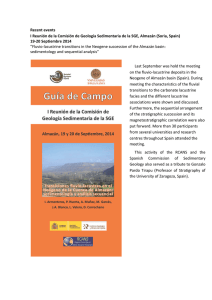
![Presentacion Chile - Canada [Modo de compatibilidad]](http://s2.studylib.es/store/data/006031439_1-d894d5d2d359230b5c2007cc916df922-300x300.png)
